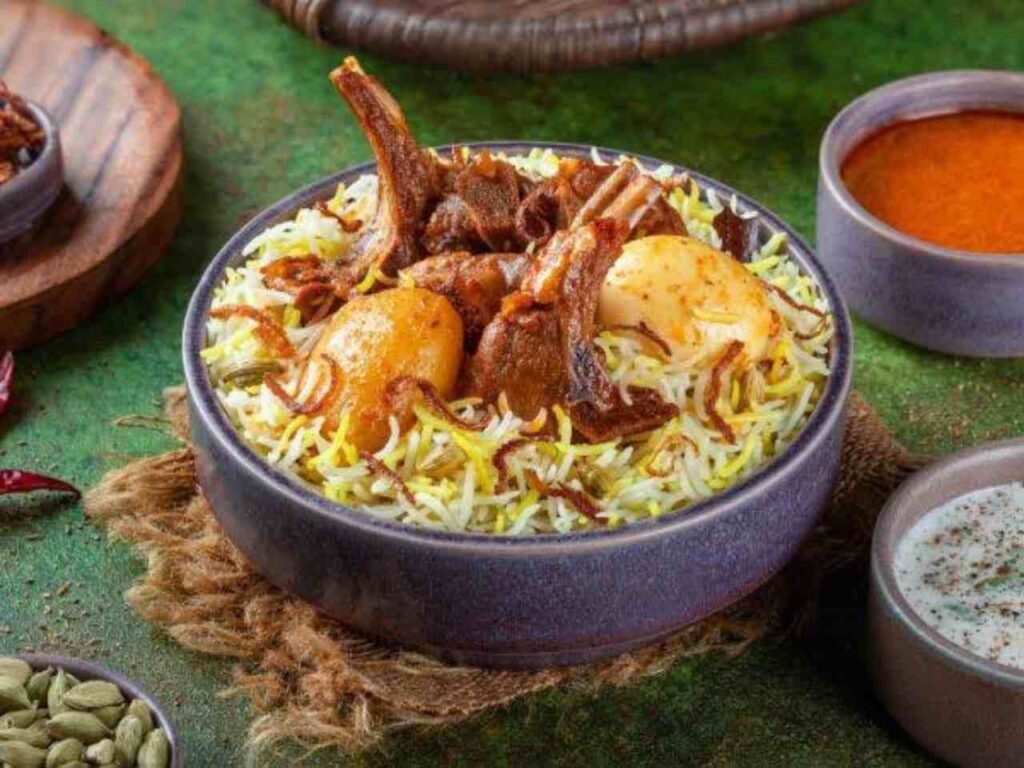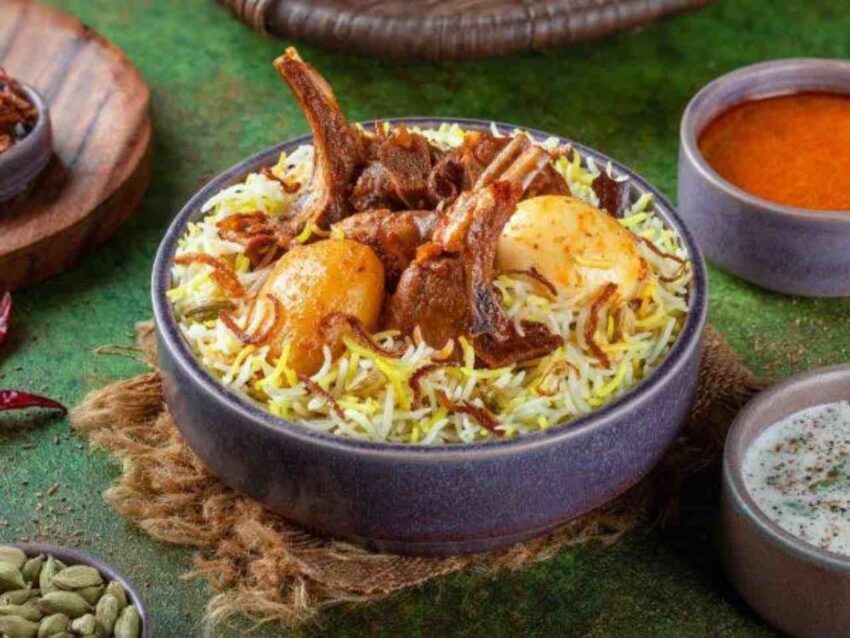
Patravali Biryani: The Ultimate Guide to Andhra’s Leaf-Plated Delight
Imagine savoring fragrant biryani, not from a plate, but from a meticulously crafted platter made of leaves. That’s the essence of Patravali Biryani, a culinary experience deeply rooted in Andhra Pradesh’s tradition and culture. This isn’t just about eating; it’s a sensory journey that connects you to the earth and the rich heritage of South Indian cuisine. This comprehensive guide will delve into every aspect of Patravali Biryani, from its historical significance to its preparation, variations, and the unique experience it offers. We’ll explore the science behind the flavors, the cultural importance of serving food on leaves, and why this dish continues to captivate food enthusiasts worldwide. Prepare to embark on a flavorful adventure that will transform your understanding of biryani.
What is Patravali Biryani? A Deep Dive
Patravali Biryani isn’t merely biryani served on a leaf; it’s a carefully curated culinary experience. The term “Patravali” refers to the platter crafted from large, dried leaves, typically those of the Butea Monosperma tree (also known as the Flame of the Forest or Palash tree). These leaves are meticulously stitched together to form a sturdy, eco-friendly plate. Serving biryani on a Patravali adds a unique earthy aroma and subtly alters the taste profile, enhancing the overall dining experience. The tradition is believed to stem from ancient practices where leaves were the primary serving vessels, reflecting a deep connection with nature and sustainable living.
The Significance of Serving Food on Leaves
The practice of serving food on leaves is deeply ingrained in Indian culture, particularly in South India. Beyond its eco-friendliness, it holds several cultural and health benefits. Leaves like those used in Patravali are believed to possess medicinal properties, adding subtle flavors and nutrients to the food. The act of eating from a natural platter connects individuals to their roots and promotes a sense of harmony with nature. Furthermore, the biodegradability of the leaves makes it an environmentally responsible choice, aligning with sustainable practices.
Patravali Biryani vs. Regular Biryani: What’s the Difference?
While the core ingredients of Patravali Biryani may resemble those of other biryani variations, the key difference lies in the serving method. The Patravali platter imparts a distinct earthy aroma and subtly alters the flavor profile of the biryani. The leaves, depending on their type and preparation, can add a slightly bitter or tangy note, complementing the richness of the biryani. This subtle nuance elevates the dining experience, transforming it from a simple meal into a cultural and sensory exploration.
The Art of Making Patravali: A Step-by-Step Guide
Crafting a Patravali is an art in itself, requiring skill and patience. Here’s a step-by-step guide to creating your own traditional leaf platter:
- Leaf Selection: Choose large, dried leaves, preferably those of the Butea Monosperma tree. Ensure the leaves are clean and free from any damage.
- Preparation: Soak the leaves in water for a few minutes to make them pliable and prevent them from cracking during stitching.
- Stitching: Using thin, natural fibers or toothpicks, carefully stitch the leaves together, overlapping them to create a sturdy platter.
- Shaping: Shape the stitched leaves into a round or oval platter, ensuring it’s large enough to hold a generous serving of biryani.
- Cleaning: Wipe the Patravali platter with a clean, damp cloth before serving.
Patravali Biryani: The Recipe (Andhra Style)
While recipes vary from region to region and family to family, here’s a classic Andhra-style Patravali Biryani recipe:
Ingredients:
- 1 kg Basmati Rice
- 1 kg Chicken or Mutton, cut into pieces
- 4 large Onions, thinly sliced
- 2 tbsp Ginger-Garlic Paste
- 4 Green Chilies, slit
- 1 cup Yogurt
- 1/2 cup Mint Leaves, chopped
- 1/2 cup Coriander Leaves, chopped
- 2 tbsp Biryani Masala
- 1 tsp Turmeric Powder
- 1/2 tsp Red Chili Powder
- 4 tbsp Ghee
- Salt to taste
- Saffron strands soaked in warm milk (optional)
- Patravali (leaf platters)
Instructions:
- Wash and soak the Basmati rice for 30 minutes.
- Marinate the chicken or mutton with yogurt, ginger-garlic paste, green chilies, biryani masala, turmeric powder, red chili powder, salt, mint leaves, and coriander leaves. Refrigerate for at least 2 hours.
- In a large pot, heat ghee and sauté the sliced onions until golden brown. Remove half of the onions and set aside for garnishing.
- Add the marinated chicken or mutton to the pot and cook until it’s partially done.
- Drain the soaked rice and add it to the pot. Add enough water to cook the rice and meat.
- Cover the pot and cook on low heat until the rice is fully cooked and the meat is tender.
- Garnish with the reserved fried onions and saffron milk (if using).
- Serve hot on Patravali platters.
Leading Brands Providing Patravali-Related Products
While Patravali Biryani is traditionally homemade, several organizations are working to bring the Patravali experience to a wider audience and promote sustainable practices. One such organization is “LeafPlates India,” a social enterprise dedicated to crafting and distributing high-quality, eco-friendly leaf plates. They source leaves sustainably from local communities and employ traditional techniques to create durable and aesthetically pleasing Patravali platters.
Features of LeafPlates India’s Patravali Platters
LeafPlates India offers a range of Patravali platters designed to enhance the dining experience while promoting sustainability.
- Sustainable Sourcing: Leaves are sourced from local communities using sustainable harvesting practices, ensuring minimal environmental impact.
- Traditional Craftsmanship: Platters are handcrafted by skilled artisans using traditional stitching techniques, preserving cultural heritage.
- Eco-Friendly Materials: Only natural, biodegradable materials are used, making the platters compostable and environmentally friendly.
- Durable Construction: The leaves are carefully stitched together to create a sturdy and leak-proof platter, suitable for serving a variety of dishes.
- Hygienic: The leaves are thoroughly cleaned and sanitized before being crafted into platters, ensuring food safety.
- Unique Aroma: The natural aroma of the leaves adds a subtle earthy note to the food, enhancing the sensory experience.
- Variety of Sizes: LeafPlates India offers Patravali platters in various sizes to accommodate different serving needs.
Advantages, Benefits, and Real-World Value of Using Patravali Platters
Using Patravali platters offers a multitude of advantages, benefits, and real-world value, both for consumers and the environment.
- Eco-Friendly: Patravali platters are a sustainable alternative to plastic or paper plates, reducing waste and minimizing environmental impact.
- Cultural Significance: They connect individuals to their cultural roots and promote traditional practices.
- Health Benefits: Some leaves are believed to possess medicinal properties, adding subtle nutrients to the food.
- Enhanced Dining Experience: The earthy aroma and subtle flavors of the leaves enhance the overall sensory experience of eating.
- Support Local Communities: Purchasing Patravali platters from organizations like LeafPlates India supports local artisans and promotes sustainable livelihoods.
- Cost-Effective: In the long run, using biodegradable platters can be more cost-effective than constantly purchasing disposable alternatives.
- Versatile: Patravali platters can be used for serving a variety of dishes, from biryani and rice to curries and snacks.
Review of LeafPlates India’s Patravali Platters
LeafPlates India’s Patravali platters offer a compelling blend of tradition, sustainability, and quality. Our experience with these platters has been overwhelmingly positive. The platters are surprisingly sturdy, capable of holding generous portions of biryani without leaking or collapsing. The earthy aroma of the leaves adds a subtle yet noticeable dimension to the dining experience, enhancing the flavors of the food. The commitment to sustainable sourcing and traditional craftsmanship is evident in the quality and aesthetic appeal of the platters.
Pros:
- Eco-Friendly: A truly sustainable alternative to disposable plates.
- Durable: Surprisingly sturdy and leak-proof.
- Aesthetically Pleasing: Beautifully crafted and adds a touch of rustic charm to any meal.
- Supports Local Communities: Contributes to the livelihoods of local artisans.
- Enhances Flavor: The earthy aroma subtly enhances the taste of the food.
Cons/Limitations:
- Availability: May not be readily available in all regions.
- Storage: Requires proper storage to prevent damage or mold growth.
- Cost: May be slightly more expensive than disposable plates (but cost effective in the long run).
- Cleaning: Not reusable, though they are compostable.
Ideal User Profile:
LeafPlates India’s Patravali platters are ideal for individuals and organizations who value sustainability, cultural heritage, and a unique dining experience. They are perfect for eco-conscious consumers, event organizers, and restaurants looking to reduce their environmental impact.
Key Alternatives:
Alternatives include disposable paper plates or reusable plastic plates. However, paper plates are not as environmentally friendly as Patravali platters, and plastic plates contribute to plastic waste.
Expert Overall Verdict & Recommendation:
LeafPlates India’s Patravali platters are a fantastic choice for anyone seeking a sustainable, culturally rich, and aesthetically pleasing dining experience. The pros far outweigh the cons, making these platters a worthwhile investment for both personal and commercial use. We highly recommend them.
Insightful Q&A Section
- Question: How do I properly dispose of Patravali platters after use?
Answer: Patravali platters are fully biodegradable and compostable. You can simply dispose of them in your compost bin or bury them in your garden. They will decompose naturally, enriching the soil. - Question: Can I reuse Patravali platters?
Answer: While Patravali platters are designed for single use, they are not meant to be reused for hygiene purposes. However, their compostable nature makes them environmentally friendly. - Question: How do I store Patravali platters to prevent damage?
Answer: Store Patravali platters in a cool, dry place away from direct sunlight and moisture. This will help prevent damage or mold growth. - Question: Are Patravali platters suitable for serving hot and oily foods?
Answer: Yes, Patravali platters are generally suitable for serving hot and oily foods. The leaves are naturally water-resistant and can withstand heat. - Question: Where can I purchase authentic Patravali platters?
Answer: You can purchase authentic Patravali platters from reputable suppliers like LeafPlates India or from local artisans in Andhra Pradesh. - Question: What types of leaves are commonly used for making Patravali platters?
Answer: The most common type of leaf used for making Patravali platters is the leaf of the Butea Monosperma tree (Flame of the Forest). - Question: How does serving food on Patravali platters enhance the dining experience?
Answer: Serving food on Patravali platters adds a unique earthy aroma and subtle flavors to the food, enhancing the sensory experience and connecting individuals to their cultural roots. - Question: Are there any health benefits associated with eating from Patravali platters?
Answer: Some leaves used for making Patravali platters are believed to possess medicinal properties, adding subtle nutrients to the food. - Question: How do Patravali platters contribute to sustainable living?
Answer: Patravali platters are a sustainable alternative to plastic or paper plates, reducing waste and minimizing environmental impact. - Question: Can I customize Patravali platters with my own designs or logos?
Answer: Some suppliers may offer customization options for Patravali platters, allowing you to add your own designs or logos.
Conclusion
Patravali Biryani is more than just a dish; it’s a celebration of culture, sustainability, and culinary artistry. From the meticulous crafting of the Patravali platter to the fragrant and flavorful biryani served upon it, every aspect of this experience is designed to delight the senses and connect individuals to their roots. By choosing Patravali Biryani and supporting organizations like LeafPlates India, you are not only savoring a delicious meal but also contributing to a more sustainable and culturally rich future. Share your experiences with Patravali Biryani in the comments below and let us know how this unique dining tradition has impacted you.

